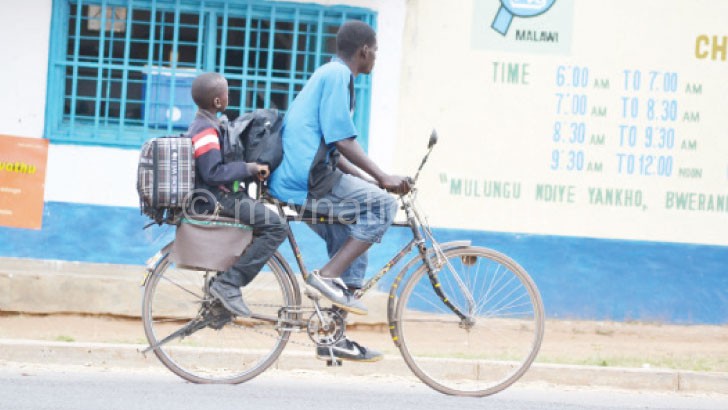A kingdom of bicycles
Bicycle taxis are one of the transport options for people in Malawi, especially in Lilongwe. With lack of public transport, those without cars turn to the bicycle taxis, popularly known as kabaza.
However, even after years of having the bicycle taxi operators plying on the roads, some people still frown upon the idea of riding a bike.
Others cannot even imagine themselves riding a kabaza to and from work. Actually, for some Malawians especially in urban setting, owning a bicycle, let alone riding one, is a sign of poverty.
In the villages, however, bicycles are not just family assets; they are also ambulances, among others.
In China, owning or riding a bicycle is not a sign of poverty but progress.
First a cultural icon, then a sign of backwardness, bicycles are one of the most common means of transport after the subway and public buses for the Asian giant.

The Chinese Government essentially encourages its citizens to get back in the saddle through bike share programmes.
Bikes and scooters maintain a prominent place in the nation’s transportation mix, and many streets give this mode of transport their proper due.
No wonder the country boasts of being arguably the world’s capital city of bicycles as it holds the record of the highest number of bicycles globally, with urbanities in megacities of Beijing and Shanghai, peddling to work.
There are around a half billion bicycles in China, roughly about 1 bicycle per household while in most places, bicycles outnumber cars at least 10 to 1, according to bicycle and cycling facts.
There are seven million registered bicycle riders in Beijing out of close to 23 million people of the city.
With more than five million cars on the road according to the city’s traffic police bureau, Beijing is plagued by gridlock. But at least there are bike lanes in the first place. Little wonder, residents call it “Shoudu”—capital of traffic jams.
While the story of gridlock is similar in Africa, the difference is that in countries like Malawi, motorists, cyclists and pedestrians wrestle for the narrow lanes that make up most of the roads.
The resultant traffic jam is not as a result of high numbers of vehicles plying on the roads but rather lack of visionary planning at the point of road network development.
Population in cities like Lilongwe has grown while the roads are the same, just like the time they were developed, in the 1970s.
As if the poor road network problem often riddled with potholes is not enough, the roads have negligible or no breathing space, with little or no possibility of expansion as the sides are littered and congested with unplanned buildings.
In China, bike infrastructure is in abundance in general terms. Marked bike lanes on sidewalks, wide and separated cycle tracks are everywhere. China clearly sees bikes not just as a thing of the past.
So there are lots of bikes to fill all the lanes, lots of parking spaces to accommodate all these bikes. It’s often covered and jammed full.
The bicycles come in an array of sizes, shapes and uses and are found on every street. From bikes with cargo beds that carry everything from trash to bags, new household furniture, to electric bikes and miniature scooters.
Apart from individuals that are part of the two-wheel revolution, the past few years have seen a rise in Chinese start-ups run sharing programmes all over the country.
With their fleets of colourful bikes that do not need docking stations.
Beijing has 700 000 shared bikes from different private companies with about 11 million registered users, equivalent to nearly half of the capital city’s population.
According to official figures, at the end of 2016, there were an estimated 18.9 million bike-sharing app users in China and the number is expected to increase this year.
Bike sharing in China is almost free. About $0.15 (about K109.50) allows one a ride on the two wheels for an hour. The dockless bike sharing provides the ultimate in convenience to the rider.
So this is how it works; a user with an account through an online payment company identifies the location of a nearby available bicycle via a smartphone app.
The app enables the user to scan a QR code to unlock the bike. Once the ride is finished, the bike is re-locked, with the cost automatically deducted from the user’s account.
The user leaves the bike wherever it is most convenient since it is tracked by the GPS system. Smartphone locations or GPS on the bike allow the next users to find them on the app.
Bicycles maintain popularity among the urbanites, mainly due to the omnipresent traffic jams of course, many do also appreciate the health and environmental benefits of cycling.
While in China, there are high chances of a pedestrian being hit by a bicycle than a car, what should be the first step for Africa and Malawi in particular? Having designated thorough fares for cyclists?
Then a special heavy-duty designed to withstand the continent’s rugged roads while carrying a mound of cargo on the carrier?
With the infrastructure supporting bike riding, can urbanites change their mindset and appreciate that peddling to work is just one of the available options of means of transportation?
Caught up in the bicycle craze, several African journalists on a 10 month programme sponsored by the Chinese Foreign Ministry, have experienced the life of peddling to work, shopping among other trips, just like millions of the citizens.
They believe bikes are part of the answers to Africa’s transportation problems as most countries reel under traffic congestions, regardless of the time of the day.
“If African countries are able to implement this, that will eliminate problems of transport, especially in countries that are experiencing traffic congestion all the time, like the capitals of some African
countries.
“I have experience with Ofo, [bike renting company] and I hope to convey this idea to my country so that it is implemented. I am a resident of the Egyptian capital, Cairo, one of the biggest cities
suffering from traffic congestion. Having people cycling will have many positives, including saving on time,” said Hossam Abd Elalem.
He actually frowned on the belief that riding a bicycle is a sign of backwardness.
“There are thousands of Chinese who own cars, but they prefer to use bicycles to save time, especially at peak times. For Africans, it is a matter of changing the mindset,” he said.
For Uganda’s Ronald Kato, Africa needs an overhaul of the transport system and that bicycles are just a small solution to yet a very big problem.
“I think it is a brilliant idea to adopt bikes as a means of transport as they are a cheap and convenient way to get around.
To a degree, if Africa can put all the necessary infrastructure, cycling in general can help but we need to invest in railways and road transport to move goods, people and services first,” he said.
At the apex of pedal power revolution in China, an eight-kilometre cycling path, unbelievably meandering above the urban landscape of the Chinese island city of Xiamen, in Fujian province was opened in March.
The world’s longest elevated bike skyway, is five metres suspended above the road.
Popularly known as ‘bike lane in the sky’, the bridge set a new standard for keeping pedestrians, cars, and cyclists happily separated. n





